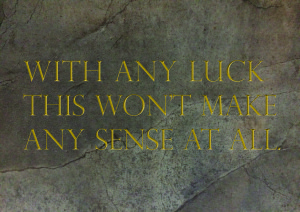The role of advertising is to create value.
The production of the advertising requires a structure.
The creation of the advertising ideas requires a lack of structure.
It takes a special kind of people to make that work.
It takes advertising people.
Some companies try to use their in-house design people as an ad hoc advertising department. While this makes sense to the financial folk inside a business. And appeals to designers with a confident view of their own abilities. Both parties often lack a real appreciation of the communication idea. As a result, not always but often enough, it ends in poor in-house design, poor advertising and poor commercial returns.
(Some companies try and do without advertising arrangements at all. Of these latter businesses, the only ones I know who do succeed have a solid reputation for providing a very good product to a small and very specific market.)
Good advertising is needed.
But the creation of good advertising defies logic.
It’s not simply a matter of paying good money to good people.
(This can work. But there are no guarantees.)
There are great creative departments filled with half-known people but steered by great managers.
And there are very talented people stuck in bad departments who can’t find a way to create great ads because there’s a kind of shit ceiling above which they cannot rise.
Like so many things in business, it comes down to the culture.
There are many, many ways to create a great creative culture. But, whether it’s good luck or good management, it’s not easy. And it’s getting harder with every tightened purse string. Not because of the money itself (although good talent often costs good money) but because of the pressures that come with trying to make a profit in a constrained economy. Managers under pressure tend to seriousness. Not surprising really. It’s hard to laugh when someone at head office draws an arbitrary line through your P&L and demands you make 25% more with 25% less.
A great creative culture is a kind of benign anarchy.
Creative people must be able to find new perspectives for products and marketing challenges. As such, they need to be able to make fun of the product. To take it very seriously and not seriously at all, at the same time. To be able to laugh at the innovations the engineers have sweated months on. To find a reason to love it. And to know why to hate it. To deride the deadlines and the budgets and the control mechanisms modern business demands.
They must have a healthy disrespect for the structures of business.
Which is very frustrating for serious business people who use those structures to measure and realise value.
Advertising people need to be able to rip at the assumptions and the traditions and the seriousness surrounding a product to find the idea of the thing.
To understand which emotional bridges they need to cross and which ones they need to burn.
To ignore the structures of intellect and logic while they take an irrational route to a place that makes perfect sense.
To use chaos to build a cathedral.


Leave A Comment